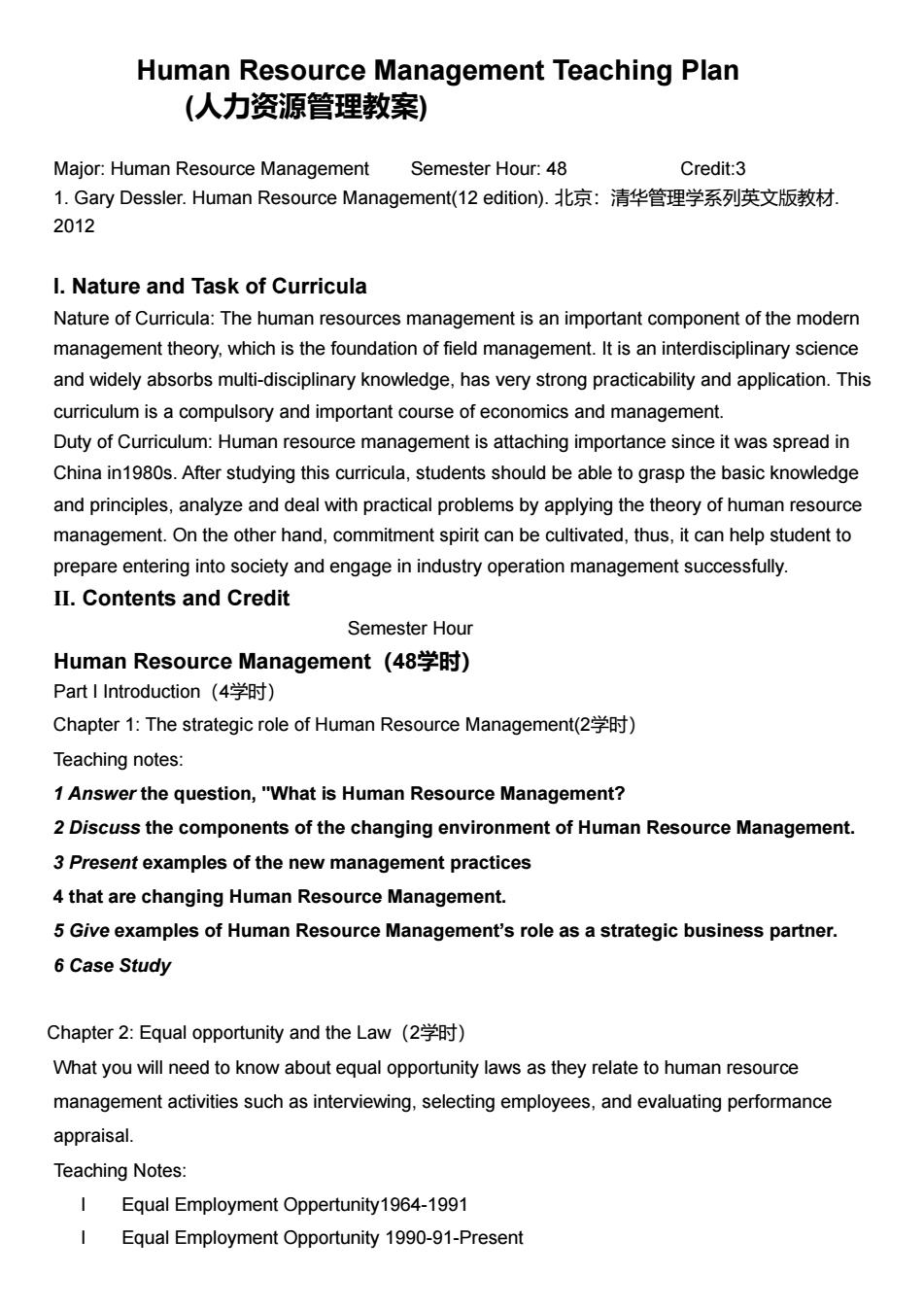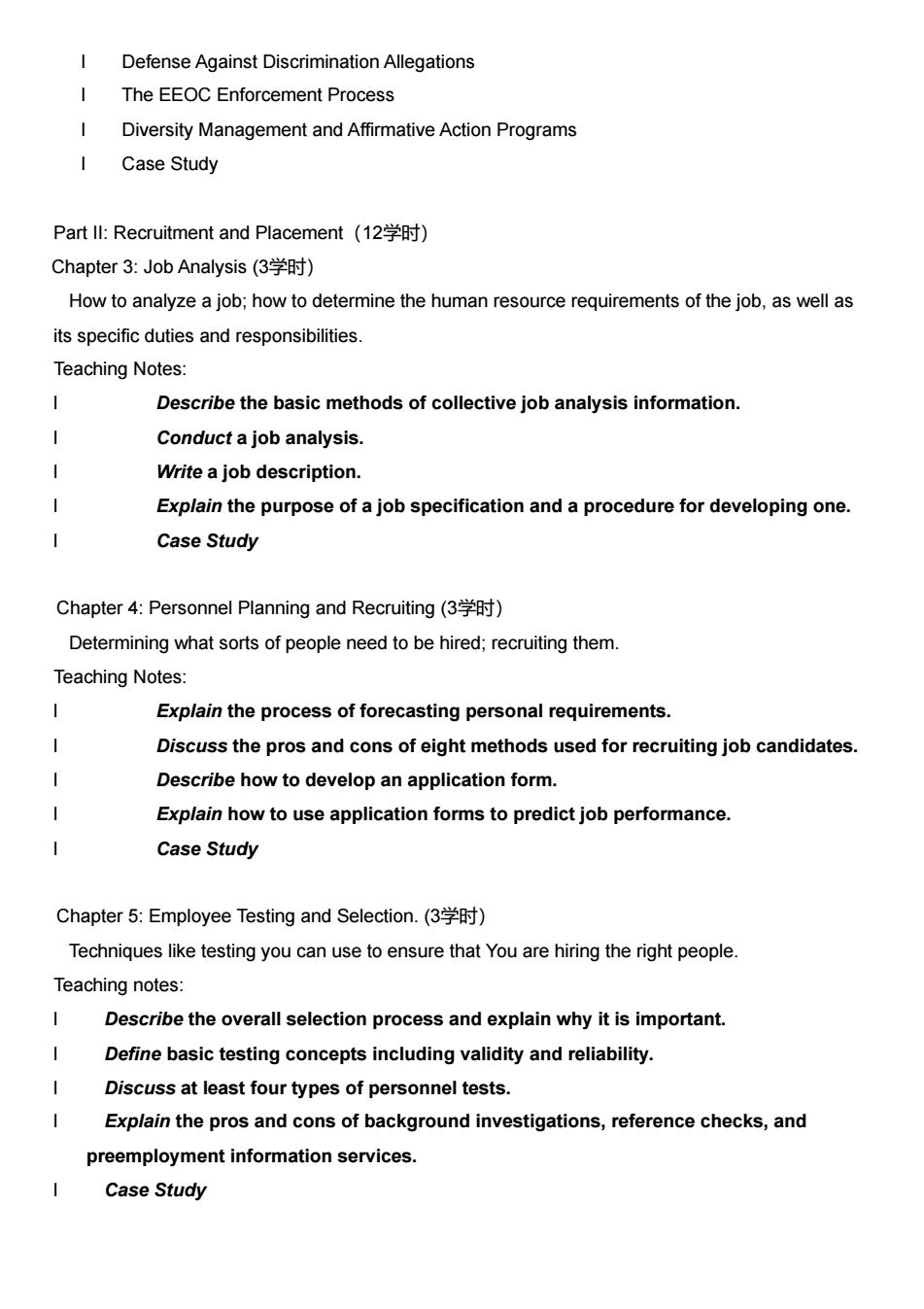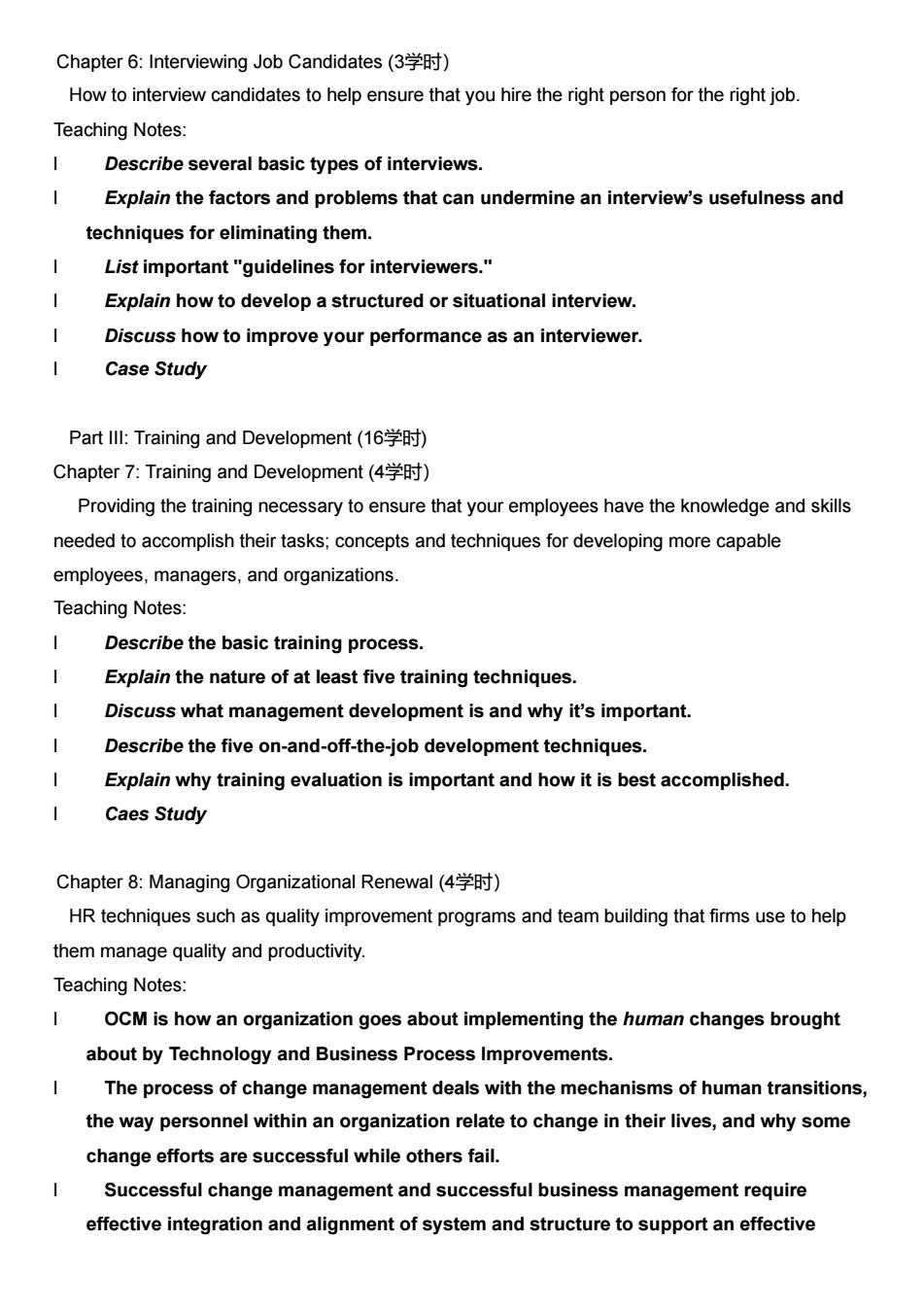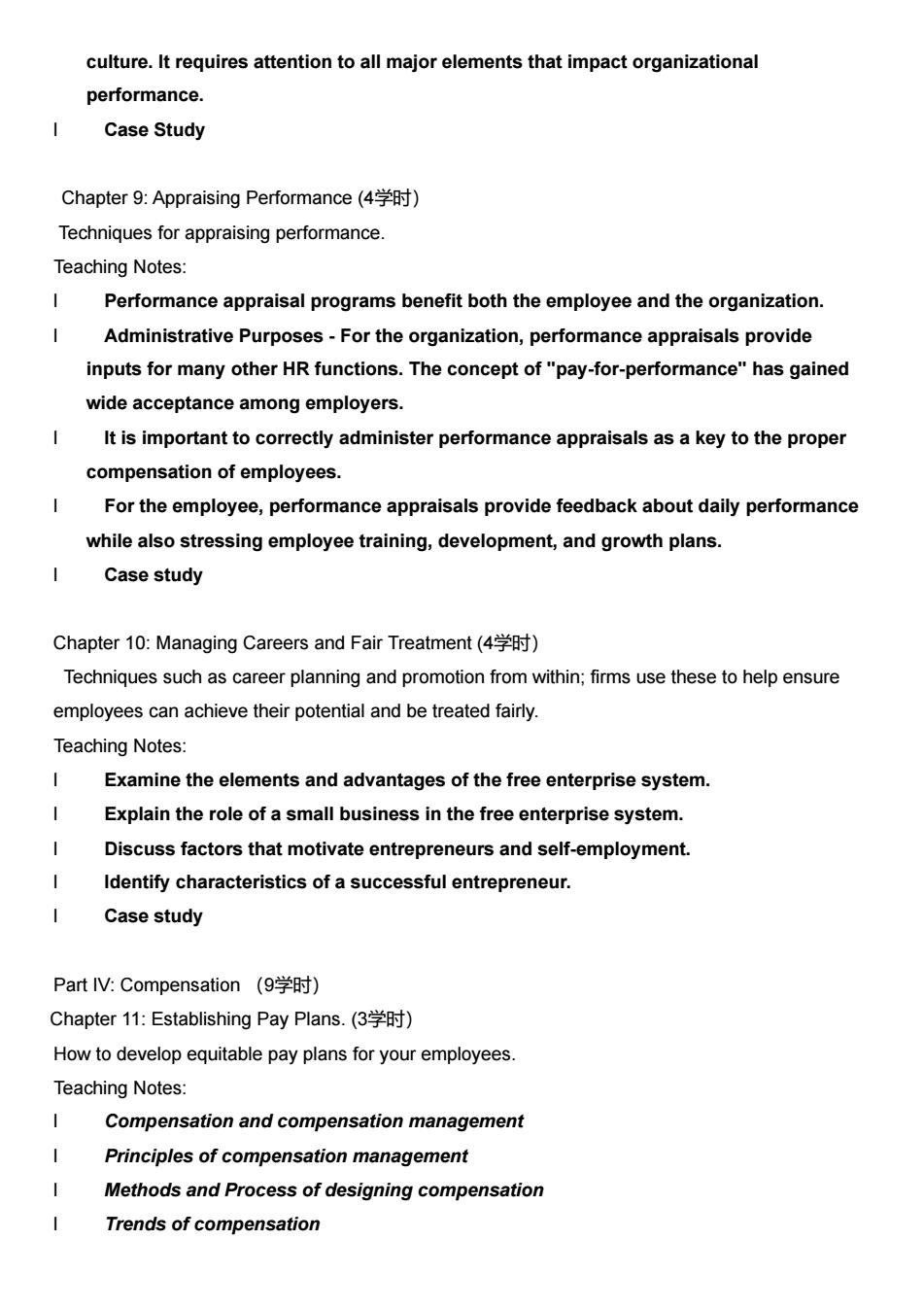
Human Resource Management Teaching Plan (人力资源管理教案) Major:Human Resource Management Semester Hour:48 Credit3 1.Gary Dessler.Human Resource Management(12 edition).北京:请华管理学系列英文版教材 2012 I.Nature and Task of Curricula Nature of Curricula:The human resources management is an important component of the modern management theory,which is the foundation of field management.It is an interdisciplinary science and widely absorbs multi-disciplinary knowledge,has very strong practicability and application.This curriculum is a compulsory and important course of economics and management. Duty of Curriculum:Human resource management is attaching importance since it was spread in China in1980s.After studying this curricula,students should be able to grasp the basic knowledge and principles,analyze and deal with practical problems by applying the theory of human resource management.On the other hand,commitment spirit can be cultivated,thus,it can help student to prepare entering into society and engage in industry operation management successfully. II.Contents and Credit Semester Hour Human Resource Management(48学时) Part I Introduction(4学时) Chapter 1:The strategic role of Human Resource Management(2 Teaching notes: 1 Answer the question,"What is Human Resource Management? 2 Discuss the components of the changing environment of Human Resource Management 3 Present examples of the new management practices 4 that are changing Human Resource Management. 5 Give examples of Human Resource Management's role as a strategic business partner. 6 Case Study Chapter2:Equal opportunity and the Law(2学时) What you will need to know about equal opportunity laws as they relate to human resource management activities such as interviewing,selecting employees,and evaluating performance appraisal. Teaching Notes I Equal Employment Oppertunity1964-1991 Equal Employment Opportunity 1990-91-Present
Human Resource Management Teaching Plan (人力资源管理教案) Major: Human Resource Management Semester Hour: 48 Credit:3 1. Gary Dessler. Human Resource Management(12 edition). 北京:清华管理学系列英文版教材. 2012 I. Nature and Task of Curricula Nature of Curricula: The human resources management is an important component of the modern management theory, which is the foundation of field management. It is an interdisciplinary science and widely absorbs multi-disciplinary knowledge, has very strong practicability and application. This curriculum is a compulsory and important course of economics and management. Duty of Curriculum: Human resource management is attaching importance since it was spread in China in1980s. After studying this curricula, students should be able to grasp the basic knowledge and principles, analyze and deal with practical problems by applying the theory of human resource management. On the other hand, commitment spirit can be cultivated, thus, it can help student to prepare entering into society and engage in industry operation management successfully. Ⅱ. Contents and Credit Semester Hour Human Resource Management(48学时) Part I Introduction(4学时) Chapter 1: The strategic role of Human Resource Management(2学时) Teaching notes: 1 Answer the question, "What is Human Resource Management? 2 Discuss the components of the changing environment of Human Resource Management. 3 Present examples of the new management practices 4 that are changing Human Resource Management. 5 Give examples of Human Resource Management’s role as a strategic business partner. 6 Case Study Chapter 2: Equal opportunity and the Law(2学时) What you will need to know about equal opportunity laws as they relate to human resource management activities such as interviewing, selecting employees, and evaluating performance appraisal. Teaching Notes: l Equal Employment Oppertunity1964-1991 l Equal Employment Opportunity 1990-91-Present

1 Defense Against Discrimination Allegations The EEOC Enforcement Process Diversity Management and Affirmative Action Programs 1 Case Study Part ll::Recruitment and Placement(12学时) Chapter3:Job Analysis(3学时) How to analyze a job;how to determine the human resource requirements of the job,as well as its specific duties and responsibilities. Teaching Notes: Describe the basic methods of collective job analysis information. Conduct a job analysis Write a job description Explain the purpose of a job specification and a procedure for developing one. Case Study Chapter 4:Personnel Planning and Recruiting (3 Determining what sorts of people need to be hired;recruiting them. Teaching Notes: Explain the process of forecasting personal requirements. Discuss the pros and cons of eight methods used for recruiting job candidates. Describe how to develop an application form. Explain how to use application forms to predict job performance Case Study Chapter 5:Employee Testing and Selection.(3 Techniques like testing you can use to ensure that You are hiring the right people Teaching notes: Describe the overall selection process and explain why it is important. Define basic testing concepts including validity and reliability. Discuss at least four types of personnel tests. Explain the pros and cons of background investigations,reference checks,and preemployment information services. Case Study
l Defense Against Discrimination Allegations l The EEOC Enforcement Process l Diversity Management and Affirmative Action Programs l Case Study Part II: Recruitment and Placement(12学时) Chapter 3: Job Analysis (3学时) How to analyze a job; how to determine the human resource requirements of the job, as well as its specific duties and responsibilities. Teaching Notes: l Describe the basic methods of collective job analysis information. l Conduct a job analysis. l Write a job description. l Explain the purpose of a job specification and a procedure for developing one. l Case Study Chapter 4: Personnel Planning and Recruiting (3学时) Determining what sorts of people need to be hired; recruiting them. Teaching Notes: l Explain the process of forecasting personal requirements. l Discuss the pros and cons of eight methods used for recruiting job candidates. l Describe how to develop an application form. l Explain how to use application forms to predict job performance. l Case Study Chapter 5: Employee Testing and Selection. (3学时) Techniques like testing you can use to ensure that You are hiring the right people. Teaching notes: l Describe the overall selection process and explain why it is important. l Define basic testing concepts including validity and reliability. l Discuss at least four types of personnel tests. l Explain the pros and cons of background investigations, reference checks, and preemployment information services. l Case Study

Chapter6:Interviewing Job Candidates(3学时) How to interview candidates to help ensure that you hire the right person for the right job Teaching Notes Describe several basic types of interviews. Explain the factors and problems that can undermine an interview's usefulness and techniques for eliminating them. List important"guidelines for interviewers." Explain how to develop a structured or situational interview. Discuss how to improve your performance as an interviewer. Case Study Part III:Training and Development(i6学时) Chapter7:Training and Development(4学时) Providing the training necessary to ensure that your employees have the knowledge and skills needed to accomplish their tasks;concepts and techniques for developing more capable employees,managers,and organizations. Teaching Notes Describe the basic training process. Explain the nature of at least five training techniques. Discuss what management development is and why it's important. Describe the five on-and-off-the-job development techniques. Explain why training evaluation is important and how it is best accomplished. Caes Study Chapter 8:Managing Organizational Renewal(4 HR techniques such as quality improvement programs and team building that firms use to help them manage quality and productivity. Teaching Notes OCM is how an organization goes about implementing the human changes brought about by Technology and Business Process Improvements. The process of change management deals with the mechanisms of human transitions, the way personnel within an organization relate to change in their lives,and why some change efforts are successful while others fail. Successful change management and successful business management require effective integration and alignment of system and structure to support an effective
Chapter 6: Interviewing Job Candidates (3学时) How to interview candidates to help ensure that you hire the right person for the right job. Teaching Notes: l Describe several basic types of interviews. l Explain the factors and problems that can undermine an interview’s usefulness and techniques for eliminating them. l List important "guidelines for interviewers." l Explain how to develop a structured or situational interview. l Discuss how to improve your performance as an interviewer. l Case Study Part III: Training and Development (16学时) Chapter 7: Training and Development (4学时) Providing the training necessary to ensure that your employees have the knowledge and skills needed to accomplish their tasks; concepts and techniques for developing more capable employees, managers, and organizations. Teaching Notes: l Describe the basic training process. l Explain the nature of at least five training techniques. l Discuss what management development is and why it’s important. l Describe the five on-and-off-the-job development techniques. l Explain why training evaluation is important and how it is best accomplished. l Caes Study Chapter 8: Managing Organizational Renewal (4学时) HR techniques such as quality improvement programs and team building that firms use to help them manage quality and productivity. Teaching Notes: l OCM is how an organization goes about implementing the human changes brought about by Technology and Business Process Improvements. l The process of change management deals with the mechanisms of human transitions, the way personnel within an organization relate to change in their lives, and why some change efforts are successful while others fail. l Successful change management and successful business management require effective integration and alignment of system and structure to support an effective

culture.It requires attention to all major elements that impact organizationa performance Case Study Chapter9:Appraising Performance(4学时) Techniques for appraising performance. Teaching Notes: Performance appraisal programs benefit both the employee and the organization. Administrative Purposes-For the organization,performance appraisals provide inputs for many other HR functions.The concept of"pay-for-performance"has gained wide acceptance among employers It is important to correctly administer performance appraisals as a key to the proper compensation of employees For the employee,performance appraisals provide feedback about daily performance while also stressing employee training,development,and growth plans. Case study Chapter 10:Managing Careers and Fair Treatment(4 Techniques such as career planning and promotion from within;firms use these to help ensure employees can achieve their potential and be treated fairly. Teaching Notes: Examine the elements and advantages of the free enterprise system. Explain the role of a small business in the free enterprise system. Discuss factors that motivate entrepreneurs and self-employment Identify characteristics of a successful entrepreneur. Case study Part IV:Compensation(9学时) Chapter11:Establishing Pay Plans.(3学时) How to develop equitable pay plans for your employees Teaching Notes: Compensation and compensation management Principles of compensation management Methods and Process of designing compensation Trends of compensation
culture. It requires attention to all major elements that impact organizational performance. l Case Study Chapter 9: Appraising Performance (4学时) Techniques for appraising performance. Teaching Notes: l Performance appraisal programs benefit both the employee and the organization. l Administrative Purposes - For the organization, performance appraisals provide inputs for many other HR functions. The concept of "pay-for-performance" has gained wide acceptance among employers. l It is important to correctly administer performance appraisals as a key to the proper compensation of employees. l For the employee, performance appraisals provide feedback about daily performance while also stressing employee training, development, and growth plans. l Case study Chapter 10: Managing Careers and Fair Treatment (4学时) Techniques such as career planning and promotion from within; firms use these to help ensure employees can achieve their potential and be treated fairly. Teaching Notes: l Examine the elements and advantages of the free enterprise system. l Explain the role of a small business in the free enterprise system. l Discuss factors that motivate entrepreneurs and self-employment. l Identify characteristics of a successful entrepreneur. l Case study Part IV: Compensation (9学时) Chapter 11: Establishing Pay Plans. (3学时) How to develop equitable pay plans for your employees. Teaching Notes: l Compensation and compensation management l Principles of compensation management l Methods and Process of designing compensation l Trends of compensation

Case study Chapter 12:Pay-for-Performance and Financial Incentives.(3 Pay-for-performance plans such as financial incentives,merit pay,and incentives that help tie performance to pay. Discuss how to use piecework,standard hour,and team or group incentive plans. Discuss how to use short-term and long-term incentives for managers and executives List the pros and cons of salary plans and commission plans for salespeople. Explain how an incentive plan might backfire and how to avoid such a problem. Case study Chapter13:Benefits and Services.(3学时) Providing benefits that make it clear the firm views its employees as long-term investments and is concemned with their welfare-such as stock ownership plans.pensions,and health plans Teaching notes: List and describe each of the basic benefits most employers might be expected to offer Explain how to reduce an employer's unemployment insurance bill. Explain why the cost of insurance benefits is increasing and identify what employers can reduce these costs. Discuss how to set up a flexible benefits program. Case study Part V:Employee Security and Safety(4学时) Chapter 14:Labor Relations and Collective Bargaining (2) Concepts and techniques concerning the relations between unions and management,including the union organizing campaign;negotiating and agreeing upon a collective bargaining agreement between unions and management and then managing the agreement via the grievance process. Teaching Notes: Describe the history of the labor movement and why workers unionize. Discuss in detail the nature of the major federal labor relation laws. Describe the process of a union drive and election
l Case study Chapter 12: Pay-for-Performance and Financial Incentives. (3学时) Pay-for-performance plans such as financial incentives, merit pay, and incentives that help tie performance to pay. l Discuss how to use piecework, standard hour, and team or group incentive plans. l Discuss how to use short-term and long-term incentives for managers and executives. l List the pros and cons of salary plans and commission plans for salespeople. l Explain how an incentive plan might backfire and how to avoid such a problem. l Case study Chapter 13: Benefits and Services. (3学时) Providing benefits that make it clear the firm views its employees as long-term investments and is concerned with their welfare-such as stock ownership plans,pensions, and health plans. Teaching notes: l List and describe each of the basic benefits most employers might be expected to offer. l Explain how to reduce an employer’s unemployment insurance bill. l Explain why the cost of insurance benefits is increasing and identify what employers can reduce these costs. l Discuss how to set up a flexible benefits program. l Case study Part V: Employee Security and Safety (4学时) Chapter 14:Labor Relations and Collective Bargaining (2学时) Concepts and techniques concerning the relations between unions and management, including the union organizing campaign; negotiating and agreeing upon a collective bargaining agreement between unions and management and then managing the agreement via the grievance process. Teaching Notes: l Describe the history of the labor movement and why workers unionize. l Discuss in detail the nature of the major federal labor relation laws. l Describe the process of a union drive and election